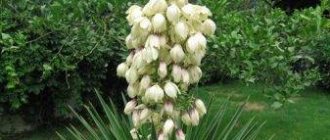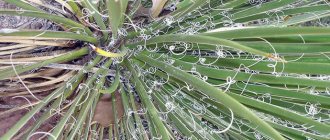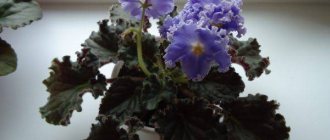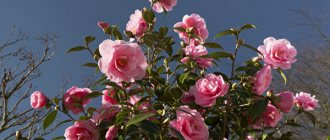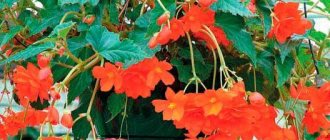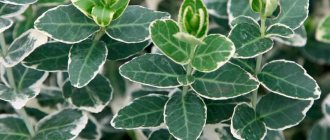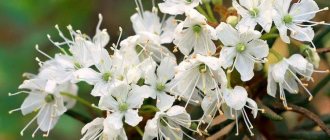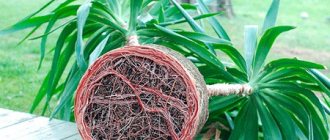A spectacular tropical plant - garden yucca - can decorate your garden plot. It is very exotic and will look spectacular in any garden.
Nowadays, yucca has received well-deserved recognition among amateur gardeners. We will try to consider issues related to its proper fit and subsequent care.
Description and photo of garden yucca
Yucca garden is a perennial shrub. Its foliage is a kind of rosette; inside it the leaves grow in a spiral shape. They are usually green or gray in color and can grow up to 25-100 cm.
In the very center there is a peduncle with white flowers. Over the course of one season, approximately two hundred bell-shaped flowers bloom on the inflorescences, reaching approximately seven centimeters in length and five centimeters in width. After flowering, the seed fruit appears.Lighting
Yucca loves well-lit places. It is advisable to place it near a window, avoiding bright rays of the sun. Grows well on the west or east side.
If street lighting is not enough, yucca feels comfortable under a fluorescent lamp.
The device is installed at a distance of 40 cm from the leaves and adjusted so that the total daylight hours are at least 16 hours.
With a lack of lighting, the leaves lose their elasticity, become stretched, and the plant weakens.
Types of garden yucca
Two types of yucca are suitable for planting in open ground:
- Gray yucca is a fairly tall plant, not demanding on the soil, and can withstand dry and frosty weather. However, it is extremely sensitive to abundant moisture and watering.
- Yucca filamentosa is a tree-like bush, its sword-shaped leaves reach a length of up to 70 cm and a width of 3 to 10 cm. It is very unpretentious and can withstand air temperatures down to -20C without damage.
Pest and disease control
Yucca is sensitive to root rot, and this most often occurs due to humidity and low temperature. In the early stages, remove damaged areas, treat with medications, replant the plant and establish a regime.
Brown spots with a yellow rim on the leaves are a symptom of anthracnose. In this case, stop spraying, lower the humidity and treat the plant with fungicides. Young trees are more likely to suffer from powdery mildew, but the control methods are the same.
Spider mites and aphids readily settle on large yucca leaves. Mealybugs and scale insects can sometimes be found. In these cases, we advise you to wipe the leaves with soapy water and then spray them with insecticides.
Photo: greendom.biz
Cineraria (60 photos): types and proper care
Yucca garden: planting and care
Before planting on the site, the yucca must be hardened off. For this purpose, it should be placed outside for several hours every day. The hardening hours are extended every day, with the result that after fourteen days the plant will be ready for planting.
Yucca is light-loving; illuminated areas on hills are ideal for it.
Using Yucca to decorate the garden
The decorative nature of Yucca allows it to be used to decorate dry areas in the garden. The plant is used to create rock gardens and form original paths. A fashionable trend is planting crops in monochrome white gardens.
Such “palm trees” look great in group compositions or single plantings. They go well with low-growing crops that have pastel-colored flowers.
Interesting fact! Fibers obtained from the plant are added to denim, a fabric used for sewing denim items. This increases the wear resistance of products.
Landing Features
Young bushes need small holes, however, further growth should be taken into account. A three-year-old yucca needs a hole with a girth of 70 to 100 cm. The root is buried approximately 40-50 cm.
The best time to prepare the soil for planting is in the fall. Clay-stony, sandy, calcareous soils and black soil are suitable for yucca. They do not tolerate excess moisture well, therefore, it is better to plant them as far as possible from groundwater. The bottom of the hole can be sprinkled with gravel, sand or ash.
After this, the bush is carefully planted, sprinkling the roots with soil. It is better to work with gloves to avoid cuts on your hands. Water not too much, regularly, using water at room temperature.
Spring is best for planting; the air temperature at the time of planting should not fall below +10C at night.
Plant propagation
Seeds
This method is used in March. The temperate climate has a beneficial effect on the ripening of planting material. Once collected, they do not need to be dried or stored. You can plant it immediately. A special substrate is used for this. You can purchase it at a specialty store or prepare it yourself. To do this, you need to take equal parts of leaf and turf soil, river sand, pre-sifted.
The seeds are small, so there is no need to dig them into the soil; they will be able to break through a thick layer of soil. It is enough to distribute them evenly over the soil surface, sprinkle with a thin layer of sand and spray with water. Afterwards, the container is covered with film or glass, leaving it in a bright, dry room. The first shoots will appear in 4 weeks. After this, the cover can be removed.
As soon as the first true leaf appears on the young shoots, they can be picked into separate containers. It is best to use peat cups to avoid damaging the fragile root system when replanting. Transfer to open ground after the formation of 4 leaves.
By cuttings
Can be done in April. To prepare planting material, the upper fragment is cut off from the stem, along with part of the foliage. Before planting, the cuttings must be dried in a dry, warm room. Root in containers with sand or peat. To ensure that the root system forms faster, the box is regularly sprayed with warm water from a spray bottle. It is transferred to open ground in June.
garden stem
Popular and effective way. Using a sharp knife, cut off part of the stem. The most suitable part is located 2 cm above the root collar. It is dried before planting. Transfer to the ground in a horizontal position. The planting hole is filled with sand or perlite. Before sprouts appear, the stem is regularly moistened.
The appearance of roots is a signal for division. The stem is divided into a certain number of seedlings, each of which must have part of the root.
Dividing the bush
This method is chosen by inexperienced gardeners because of its simplicity. In mid-April, an adult healthy bush suitable for division is dug around. Carefully removing them from the soil, separate the “babies” from it. This is almost always a large number. Each should have part of the root and shoots.
Watering and subcortex
Yucca does not require special conditions and care. It should be watered regularly, but infrequently, after the top layer of soil has dried. Sometimes you can spray the leaves with water, especially if they dry out.
It is best to carry out this procedure in the evening or early morning.
During growth, the plant needs to be fed twice with minerals. First - in May, at the beginning of the growing season, then - immediately after flowering ends.
Soil and fertilizers
At home, yucca flower is quite easy to grow, since it is unpretentious in terms of soil and fertilizers used. As for the soil, it can be absolutely anything, but you need to ensure that the soil structure provides good drainage. For example, 50% sand and 50% compost would be the ideal soil composition for growing yucca. You can also use soil, but it is recommended to use a layer of fine gravel along with it at the bottom of the pot, which will perform drainage functions.
Considering the issue of fertilizers, it should be noted that proper cultivation of yucca flowers involves feeding the plant during the period of its maximum vegetative activity, that is, during the spring-summer period. At this time, fertilizer should be applied to the soil of the pot with the plant once a month in liquid form.
You can buy fertilizer for home flowers at a flower shop. At the same time, you need to pay attention to the fact that the fertilizer contains a large amount of nitrogen, which is necessary for the growth of green mass of the plant. The fertilizer must contain macroelements (phosphorus, potassium), as well as microelements (magnesium, iron, manganese, copper, zinc, boron and molybdenum). All of them are necessary for the balanced growth and development of the yucca flower, as well as for its fight against pests and possible diseases.
Yucca garden diseases
Yucca gets sick quite rarely. Sometimes plants experience yellowing and wilting of leaves. If this happens to the lower leaves of the plant, there is no need to worry - they tend to wither and fall off over time, this is a natural process.
Also, yellowing of the leaves occurs in cases where the plant is exposed to a draft or is frozen.
Clarkia graceful - varieties and types, care and planting, diseases + 78 photos- Irises - description of the species, cultivation, reproduction + 102 photos
Campsis - planting, care, location rules, watering, types of reproduction (67 photos + video)
World experience in using Yucca
The perennial tree plant Yucca is part of the Agave family. This genus includes about 40 species that naturally occur in the subtropical zone of North America. In the homeland of this plant it is used in various fields. Juice, which is high in sugar, is extracted from cut flowers. Threaded Yucca is used to make strong fibers that were used to make the first jeans and were later replaced by cotton. However, even today in the USA, Yucca is added to the fabric used to make jeans, making it stronger and more wear-resistant. In addition, Yucca fibers are used to make rope and paper. Also, in addition to all its advantages, Yucca has healing properties.
Transfer
With prolonged growth, the yucca grows and requires replanting, but it must be remembered that frequent replanting is harmful to the plant. Experienced gardeners in such cases recommend:
- Transplantation is carried out either in spring or at the end of summer. You need to remove the plant from the ground carefully, without damaging the roots. The emerging shoots are separated and planted separately.
- The new landing site should not be fundamentally different from the previous one.
- The area for planting yucca should be as light as possible.
- The transplanted plant needs to be fed after fourteen days. Flowering should be expected after a year from the moment of transplantation.
Comfort zone
When choosing a place where your new favorite will now grow, imagine its homeland - California or the Caribbean - and feel free to place the pot near a window facing south. Take care to protect it from harsh sunlight and contact with glass.
The flowerpot can also be placed in partial shade, where the agave plant will also be comfortable, although in this case you should not expect lush tropical greenery to appear.
With the onset of warm days, the plant can be taken out to the balcony or moved to the dacha, decorating the garden plot with a “palm tree”. Here she will receive the maximum amount of light.
Insulation of garden yucca
A logical question often arises - how to properly insulate a garden yucca for the winter and is it necessary to do it?
Filamentous and glaucous yucca are frost-resistant, being quite painless in the face of a short drop in air temperature. In regions with cold winters, garden yucca needs to be insulated.
There are several methods of insulation:
Collect yucca leaves and tie them with twine. To prevent the ground from freezing, place the lower leaves on the ground. The soil near the bush is covered with dried leaves, and boards are laid on top to prevent it from being blown away by the wind.
After this, the bush is covered with polyethylene, the lower part of the trunk is sprinkled with soil.
Bacopa - description of the species, cultivation, care, reproduction + 74 photos- Garden hibiscus - types, description, planting, care and propagation + 69 photos
- Celosia - growing from seeds and seedlings, planting in the ground and care rules + 80 photos
There is another method of insulation - using a large wooden box covered with dense material, roofing felt or polystyrene foam will do. Then the insulating structure is covered with dried leaves, after which it is covered with spruce branches or straw, and a film can be placed on top.
It is recommended to carry out insulation in late autumn, at the end of October-November, and it is worth removing the protection only when any threat of cold weather and frost has passed.
Garden yucca will help create an unusual exotic corner on your site. This beautiful tropical plant is extremely unpretentious. With proper care, yucca will delight you for a very long time.
Yucca in landscape design
Yucca in the garden immediately gives the surrounding landscape a hint of the Mediterranean or even the Mexican prairie. It is appropriate on gravel dumps, in the driest places. Its palm-shaped appearance gives the garden an overseas flavor. Therefore, where terracotta and other stylistic goodies are used in the garden, yucca will be a great addition.
Of course, garden yuccas look advantageous in solitary plantings - gradually growing clumps become a visual accent both in flat landscapes and on terraces. A single yucca during the flowering period will become a real fireworks display, from which it will be difficult to take your eyes off.
In addition, yuccas are also suitable as a side crop - in large voluminous tubs. On rocky or tiled patios, on staircases, verandas and other architectural quirks, outdoor yuccas in flowerpots look great. In the south, such solutions do not require either winter shelter or special wintering premises.
Street yuccas are planted in mixborders and flower beds. Companions are selected that are drought-resistant and sun-loving. These can be sage, daylily, bearded irises, liatris, yarrow, helenium, coreopsis. In flower beds, as a rule, yuccas are placed in the center.
With good drainage, garden yucca can grow with moisture-loving plants - hostas and ferns, although such combinations are unnecessary (photo 2014)
Yucca is very attractive during the flowering period
The varieties and forms of garden yucca are very beautiful, and planting and caring for the plant is completely easy. She has a very friendly character and grows in one place without transplantation for a long time - 10 years or more. Find a place with good drainage for your yucca, and it will delight you for many years.
